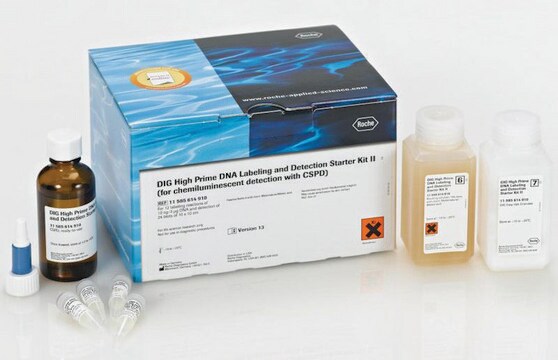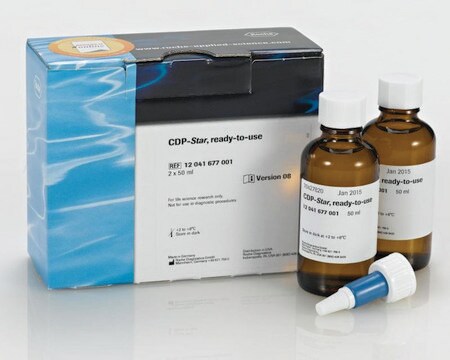11585762001
Roche
DIG Wash and Block Buffer Set
storage temp.:2-8°C
Sinonimo/i:
wash and block buffer set, dig
Autenticatiper visualizzare i prezzi riservati alla tua organizzazione & contrattuali
About This Item
Codice UNSPSC:
41105326
Prodotti consigliati
Livello qualitativo
Produttore/marchio commerciale
Roche
Caratteristiche più verdi
Designing Safer Chemicals
Learn more about the Principles of Green Chemistry.
sustainability
Greener Alternative Product
Categoria alternativa più verde
, Aligned
Temperatura di conservazione
2-8°C
Descrizione generale
Except for the Blocking solution, the 10x concentrated buffers are diluted to the desired concentrations with sterile double-distilled water (not included).
Washing, blocking and detection buffers (10x concentrated) for the immunological detection of DIG - (digoxigenin-)labeled probes.
Washing, blocking and detection buffers (10x concentrated) for the immunological detection of DIG - (digoxigenin-)labeled probes.
We are committed to bringing you Greener Alternative Products, which adhere to one or more of The 12 Principles of Greener Chemistry. This product is designed as a safer chemical. The DIG System was established as a sensitive and cost-effective alternative to using radioactivity for the labeling and detection of nucleic acids. There are many available publications that prove the versatility of the DIG System, so use of radio-labeling is no longer the only option for labeling of DNA for hybridization.
Applicazioni
The DIG Wash and Block Buffer Set is used at various steps of DIG hybridization and DIG detection.
Confezionamento
1 set containing 4 components.
Nota sulla preparazione
Working solution: dATP, dGTP, dTTP mixture:
For one labeling reaction pipette:
1 μl dATP, (vial 2)
1 μl dGTP, (vial 4)
1 μl dTTP, (vial 5)
to a reaction vial.
Note: If the same type of labeled deoxyribonucleoside-triphosphate is used repeatedly, we recommend the preparation of a mixture of equal parts of the other three deoxyribonucleoside-triphosphates for convenience.
Storage conditions (working solution):
For one labeling reaction pipette:
1 μl dATP, (vial 2)
1 μl dGTP, (vial 4)
1 μl dTTP, (vial 5)
to a reaction vial.
Note: If the same type of labeled deoxyribonucleoside-triphosphate is used repeatedly, we recommend the preparation of a mixture of equal parts of the other three deoxyribonucleoside-triphosphates for convenience.
Storage conditions (working solution):
- After the first usage, the buffers should be stored further at 2 to 8 °C. We recommend to store the concentrated Blocking solution in aliquots at -15 to -25 °C.
- When Autoclaved: Stock solution can be stored for several days to a week either unopened at RT or at 2 to 8 °C after opening. Alternatively, it can be stored in aliquots at -15 to -25 °C for up to 6 months.
Risultati analitici
The buffers are autoclaved, filtered and tested for the absence of DNases and RNases according to the current Quality Control procedures. The buffers are function tested according to the standard procedure of the DIG Nucleic Acid Detection Kit.
Altre note
For life science research only. Not for use in diagnostic procedures.
Solo come componenti del kit
N° Catalogo
Descrizione
- Washing Buffer 10x concentrated
- Maleic acid Buffer 10x concentrated
- Blocking Solution 10x concentrated
- Detection Buffer 10x concentrated
Avvertenze
Warning
Indicazioni di pericolo
Consigli di prudenza
Classi di pericolo
Eye Irrit. 2 - Skin Irrit. 2
Codice della classe di stoccaggio
12 - Non Combustible Liquids
Classe di pericolosità dell'acqua (WGK)
WGK 3
Punto d’infiammabilità (°F)
Not applicabledoes not flash
Punto d’infiammabilità (°C)
Not applicabledoes not flash
Scegli una delle versioni più recenti:
Possiedi già questo prodotto?
I documenti relativi ai prodotti acquistati recentemente sono disponibili nell’Archivio dei documenti.
I clienti hanno visto anche
Shiho Torii et al.
Cell reports, 35(3), 109014-109014 (2021-04-12)
Severe acute respiratory syndrome coronavirus 2 (SARS-CoV-2) has been identified as the causative agent of coronavirus disease 2019 (COVID-19). Although multiple mutations have been observed in SARS-CoV-2, functional analysis of each mutation of SARS-CoV-2 has been limited by the lack
James A Baum et al.
Journal of economic entomology, 105(2), 616-624 (2012-05-23)
The plant bugs Lygus hesperus Knight (Hemiptera: Miridae) and L. lineolaris (Palisot de Beauvois) have emerged as economic pests of cotton in the United States. These hemipteran species are refractory to the insect control traits found in genetically modified commercial
Dan Sun et al.
Oncology letters, 20(4), 8-8 (2020-08-11)
Since human bladder cancer (BC) is a common malignancy of the urinary system with poor prognosis, it is crucial to clarify the molecular mechanisms of BC development and progression. To the best of our knowledge, the current study demonstrated for
Siqian Feng et al.
Genetics, 217(3) (2021-03-28)
We describe a simple and efficient technique that allows scarless engineering of Drosophila genomic sequences near any landing site containing an inverted attP cassette, such as a MiMIC insertion. This two-step method combines phiC31 integrase-mediated site-specific integration and homing nuclease-mediated
Stefanie Wehner et al.
RNA biology, 11(11), 1467-1478 (2014-12-09)
6S RNA is a highly abundant small non-coding RNA widely spread among diverse bacterial groups. By competing with DNA promoters for binding to RNA polymerase (RNAP), the RNA regulates transcription on a global scale. RNAP produces small product RNAs derived
Il team dei nostri ricercatori vanta grande esperienza in tutte le aree della ricerca quali Life Science, scienza dei materiali, sintesi chimica, cromatografia, discipline analitiche, ecc..
Contatta l'Assistenza Tecnica.









![CDP-Star® Disodium 2-chloro-5-(4-methoxyspiro {1,2-dioxetane-3,2′-(5′-chloro)tricyclo[3.3.1.13,7 ]decan}-4-yl)-1-phenyl phosphate](/deepweb/assets/sigmaaldrich/product/structures/224/846/d08963f5-c8ba-42e6-b4f7-9ee7fd76d809/640/d08963f5-c8ba-42e6-b4f7-9ee7fd76d809.png)